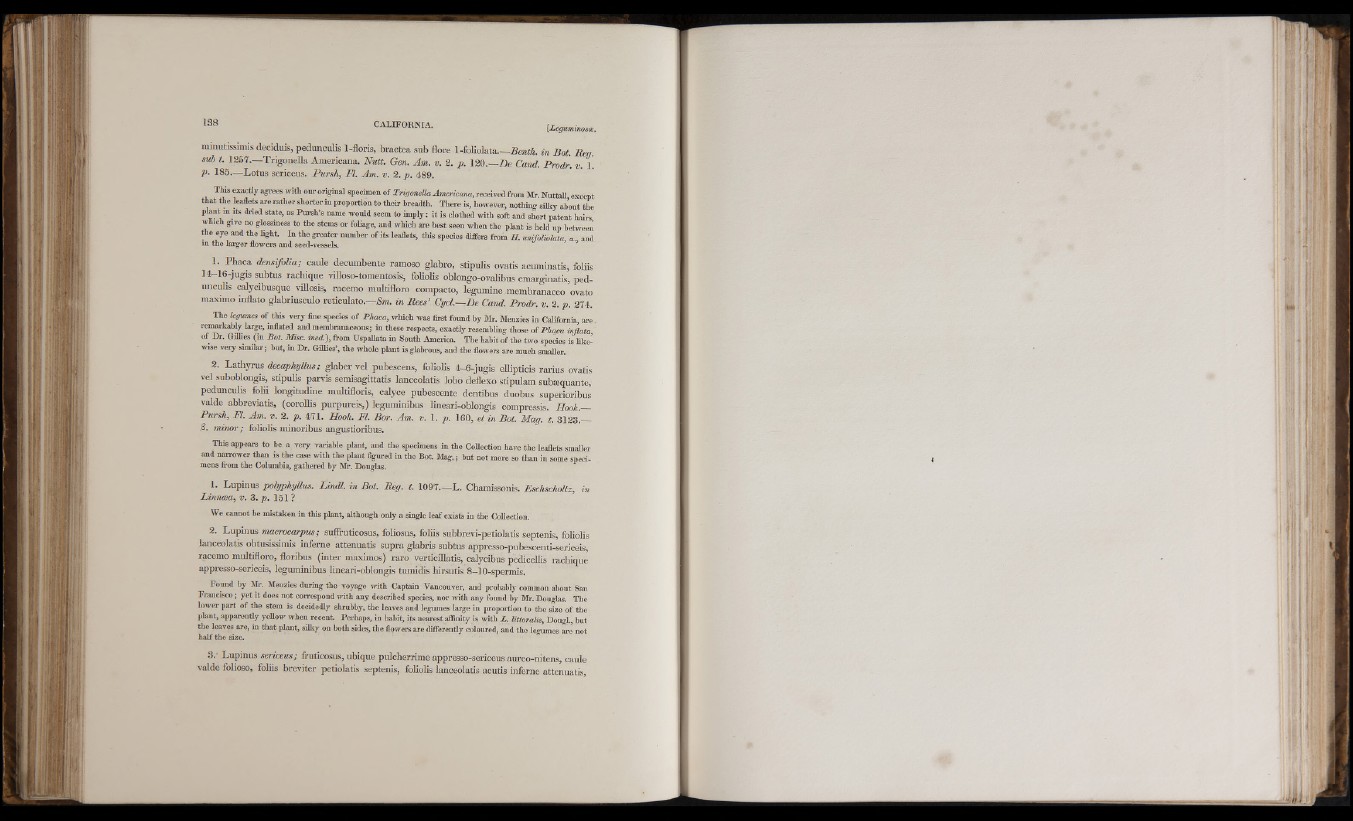
minutissimis deciduis, pedunculis 1-floris, brnctea sub flore l-foliolota.—Dotî/î. in Bot. Beg.
sub t. 1837.— Trigonello Americana. Nutt. Gen. Am. v. 2. p . 120.— De Cand. Prodr. ». 1.
p . 185.—Lotus sericeus. P ursh, Fl. Am. ». 2. p . 489.
This exncfly agrees with oar original specimen of TrigoneOa Americana, received from Mr. Nuttall except
that the leaflets are rather shorter in proportion to their breadth. There is, however, nothing silky about the
plant in its dried state, as Pursh's name wotdd seem to imply: it is clothed with soft .and short patent hairs
wEich give no glossiness to the stems or fobage, and wbich are best seen wbcn the plant is bold up botweej;
the eye and the light. In the greater number of its leaflets, this species differs from H. unifoliolata a. and
in the larger flowere and seed-vessels. ’ ’’ *
1. Phac a demsifolia; c.aule decumbente ramoso glabro, stipulis ovatis acuminatis, foliis
14-16-jugis subtns rachique villoso-tomentosis, foliobs oblongo-ovalibus emarginatis, pedunculis
calycibusque vdlosis, racemo multifloro compacto, legumine membramaceo ovato
raaximo mflato gkabrinsculo reticulato.—S m . in Rees' Cycl.— De Cand. Prodr. ». 2 . p . 274.
Tho legumes of this very fine species of Phaca, which was fiixt fonnd by Mr. Menzies in California, are
remarkably large, inflated and membranaceous; in these respects, exactly rcsembUng those of Phaca infiata
of Dr. Gillies (m Bot. Misc. ined.), from UspaUata in South America. The habit of the two species is hkel
wise very similar; but, in Dr. GilHcs’, the whole plant is glabrous, and the flowers are mnch smaller.
2. L athyrus decaphyllus; glaber vel pubescens, foliolis 4-6-jugis ellipticis rarius ovatis
vel suboblongis, stipufls parvis semisagittatis lanceolatis lobo deflexo stipulam subæquante,
pedunculis folii longltudine midtifloris, calyce pubescente dentibus duobus superioribus
valde abbreviatis, (corollis purpuréis,) leguminibus lineari-oblongis compressis, Hooh.—
Pursh, Fl. Am. v. 2. p . 471. Hooh. Ft. Bar. Am. ». 1. p . 160, et in Bot. Mag. t. 3123.
minor ; foliolis minoribus angustioribus.
This appears to be a very variable plant, and the specimens in the Collection have the leaflets smaller
and narroAver than is the case with the plant figured in the Bot. Mag.j but not more so than in some specimens
from the Columbia, gathered by Mr. Douglas.
1. Lupinus polyphyllus. Lin d l. in Bot. Bey. t. 1097.—L. Chamissonis. EschschoUz, in
Linnæa, v .S . p . 151 ?
We cannot be mistaken in this phmt, although only a single leaf exists in the Collection.
2. Lupinus macrocarpus; suffruticosus, foliosus, foliis subbrevi-petiolatis septenis, foliolis
lanceolatis obtusissimis infeme attenuatis supra glabris subtus appresso-pubescenti-sericeis,
racemo multifloro, floribus (inter máximos) raro verticillatis, calycibus pedicellis rachique
appresso-sericeis, leguminibus lineari-oblongis tumidis hirsutis 8-10-spermis.
Foimd by Mr. Menzies during the voyage Avith Captain Vancouver, and probably common about San
Francisco; yet it does uot correspond Avith any described species, nor Avith any found by Mr. Douglas. The
loAver part of the stem is decidedly shrubby, the leaves and legumes large in proportion to the size of the
plant, apparently yellow when recent. Perhaps, in habit, its nearest affinity is Avith L . littoralis, Dough, but
the leaves are, in that plant, silky on both sides, the flowers are differently coloured, and the Icfmmes ai-e not
half the size. ”
3. Lupinus sericeus; fruticosus, ubique pulcherrime appresso-sericeus aureo-nitens, caule
valde folioso, foliis breviter petiolatis septenis, foliolis lanceolatis acutis inferne attenuatis,